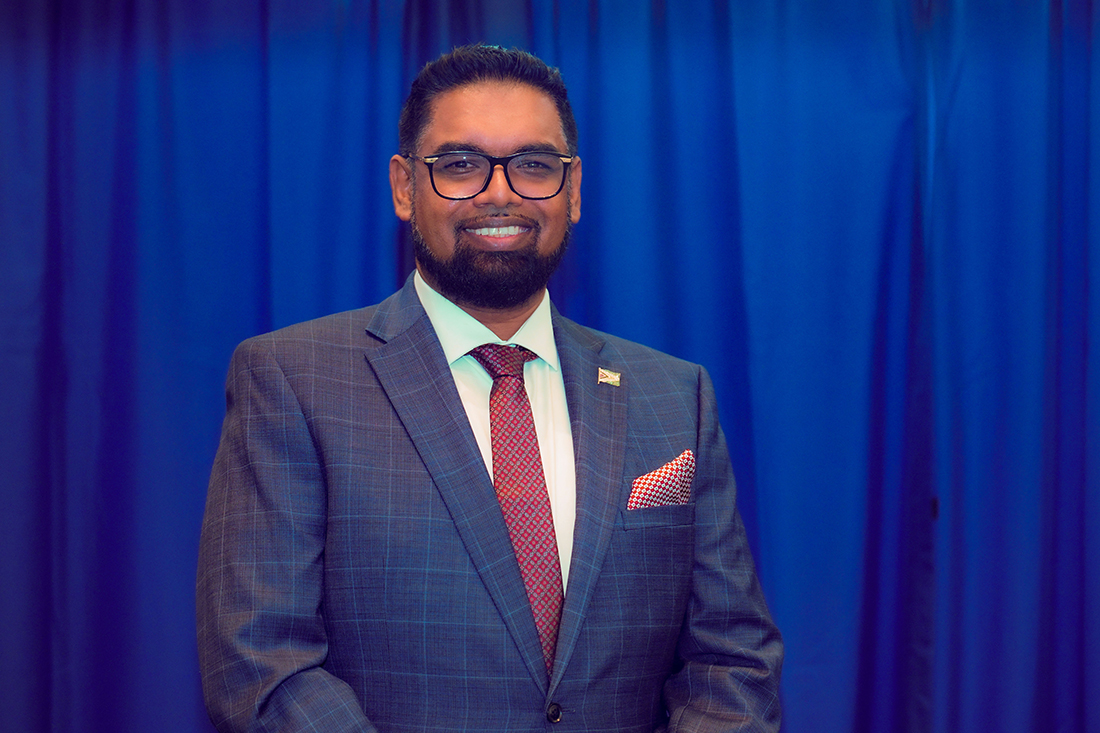
30 Jun Interview with Mohamed Irfaan Ali, President of the Cooperative Republic of Guyana
At the heart of Guyana’s national agenda is the One Guyana strategy, aimed at strengthening unity and empowering citizens. Can you tell our reader about your ‘One Guyana’ initiative to foster national unity and its importance for the country?
Our development agenda is people-centered and people-driven. Over the past five years, we have focused on building human capital and infrastructure, with major investments in healthcare, education and social services to improve quality of life and enhance system efficiency. Our goal is to position Guyana for a competitive, technology-driven future — through digitization, expanded access to technology and infrastructure that unlocks new economic opportunities and raises living standards for individuals and communities alike.
We are also investing in community well-being — beautifying public spaces, promoting mental health and strengthening family support systems. Social benefits are designed to support both children and the elderly, making everyday life easier. All of these efforts are part of the One Guyana initiative, which promotes national unity, equity and inclusive prosperity for all Guyanese.
Outside of the oil sector, how successful has Guyana been in building strong, sustainable industries, such as agriculture and ecotourism? How important is diversification to the national agenda and which specific industries are you prioritizing for long-term sustainable growth?
Guyana has achieved remarkable success. Our strategy is rooted in economic diversification — leveraging the gains from oil and gas to strengthen traditional sectors while developing new ones. We are investing heavily in tourism, agriculture, innovation, technology and human capital to build a resilient, future-ready economy. Our goal is to position Guyana as a regional leader in energy, food security, climate action and integration. At the same time, we are advancing our Low Carbon Development Strategy, ensuring sustainable growth within a strong environmental framework.
With so many examples of poor oil revenue management, what concrete steps is your administration taking to ensure that the benefits of the oil boom are distributed equitably across all sectors of Guyanese society?
I prefer not to say ‘distributed.’ The revenues from oil and gas must be invested. We are channelling these resources into people, communities and the economy to create wealth and improve livelihoods. This is about building national prosperity and individual opportunity through support for SMEs, local entrepreneurship and investment in future-ready sectors. Our local content Legislation ensures that the private sector benefits and grows alongside international partners. We are also offering fiscal incentives to develop Guyana as a hub for global health, education and other services. To avoid the pitfalls faced by other countries, we have created a transparent, accountable system. Spending from the Natural Resource Fund requires parliamentary approval and is fully integrated into the national budget, ensuring all sectors of society are included in the process.
How vital is the U.S. as a strategic partner in maintaining Guyana’s national security and energy security, especially in light of the recent tensions with Venezuela?
While we maintain partnerships globally, the United States is a key strategic partner for Guyana. The U.S. private sector plays a vital role in our development, particularly through investment, trade and security collaboration. Our relationship is rooted in shared values and a common vision for regional prosperity. Together, we are working to strengthen systems that support energy and food security, regional infrastructure and national defence. The U.S. continues to be instrumental in supporting Guyana’s growth and safeguarding our sovereignty.
Miami and Florida are also key hubs in the Americas. What specific strategies are you implementing to strengthen economic ties, collaboration, trade with this region in particular and across sectors?
Miami’s proximity to Guyana and its pool of sophisticated investors make it a key focus for us. We have actively engaged both the private sector and institutions at the state level. For example, the University of Miami’s School of Architecture is a key partner in developing our Silica City. We are even exploring twinning the new city with Miami. There is tremendous opportunity there and we are committed to catalysing it.
How would you sum up your key priorities or your vision for your next mandate leading up to 2030?
My mandate is about continuity — building a stronger, more sustainable Guyana. I aim to turn five years into ten, working around the clock to advance key projects: the new city, expanded infrastructure, the deep-water port and integrating innovation and AI into daily life. We are also focused on developing human capital and investing heavily in food security to fully position Guyana for long-term success.
With so many international investors are looking at Guyana right now, what is the one key message you would like to convey to them regarding the investment environment and the opportunities available in Guyana?
In the next 10 years, Guyana will be a prosperous nation where all citizens benefit and the country plays a meaningful role in the global economy. We aim to be a model for democracy, the rule of law, skilled human capital and leadership in health, education, energy, climate and food security. Guyana will become a global brand for sustainable, resilient and responsible development.



Sorry, the comment form is closed at this time.